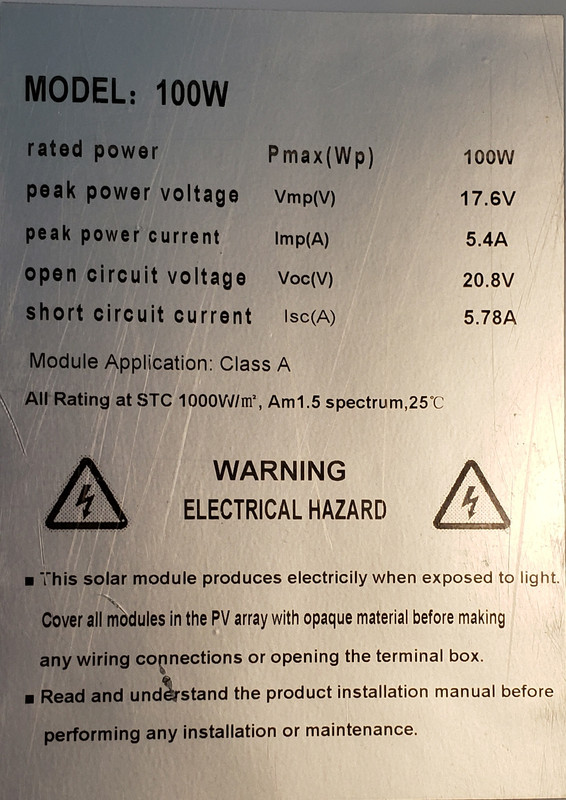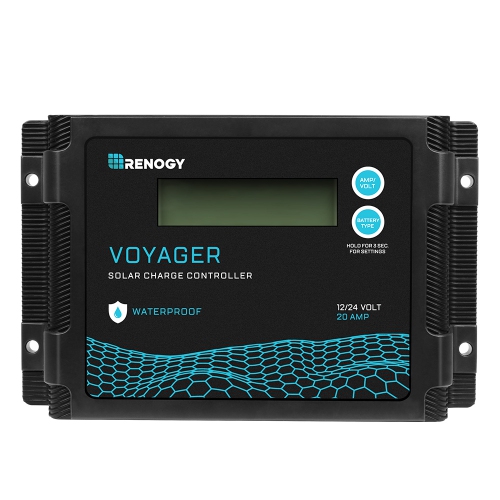- Good Sam Community
- Everything RV
- Technical Issues
- Re: A few more questions about solar panels...
- Subscribe to RSS Feed
- Mark Topic as New
- Mark Topic as Read
- Float this Topic for Current User
- Bookmark
- Subscribe
- Mute
- Printer Friendly Page
A few more questions about solar panels...
- Mark as New
- Bookmark
- Subscribe
- Mute
- Subscribe to RSS Feed
- Permalink
- Report Inappropriate Content
Jul-31-2022 11:41 AM
https://www.rv.net/forum/index.cfm/fuseaction/thread/tid/30348700.cfm
I've since bought a new controller (because the old one would show the batteries as Charged even though they obviously weren't) and I've come across another puzzle....
The controller is a RENOGY Voyager, rated at 20 amps which should be sufficient for my 100W panels.
Here are the details of my solar panels: The first is an offshore-made flexible type...

and the second is a rigid style, like the type you get mounted to a roof...

As you can see, the specs are fairly close and do NOT exceed the ratings on the controller.
Here's the interesting part; when I connect only ONE panel I get a charging current of around 2-3A.
If I connect the second one in parallel, the charging current either stays the same or decreases slightly.
The controller has built in reverse polarity protection and it gives no errors, so I'm 99.9% certain that the panels are connected properly.
So why am I getting LESS current with the second panel connected?
Does the controller sense that less is required because the batteries are fully charged (still connected to shore power)?
- Mark as New
- Bookmark
- Subscribe
- Mute
- Subscribe to RSS Feed
- Permalink
- Report Inappropriate Content
Aug-17-2022 05:18 PM
Spent the past two weeks "dry camping" and we brought along our "spare" 100W rigid solar panel.
With the new charge-controller in action, we had ZERO issues with the batteries this time.
By the end of the second week, I put away the rigid panel and just used the flexi-panel on the roof. Controller was drawing between 5 and 7 amps first thing in the morning and was down to 1 or 2 by noon...into fractions by dinner time.
I call it a success.
- Mark as New
- Bookmark
- Subscribe
- Mute
- Subscribe to RSS Feed
- Permalink
- Report Inappropriate Content
Aug-01-2022 01:21 PM
CA Traveler wrote:Qwazert wrote:Absolutely and then you'll need another 100W and then another... :B
Everything appears to be working as it should...but I need AT LEAST another 100W of solar-grabbing capacity.
Well, as I mentioned a few weeks back...my buddy has two 95W panels on his roof, the same batteries and never has an issue.
We have similar camping "styles" and similar RV's. If I get another 100W flexi-panel...I'll be 10W up on him. 😄
- Mark as New
- Bookmark
- Subscribe
- Mute
- Subscribe to RSS Feed
- Permalink
- Report Inappropriate Content
Aug-01-2022 12:34 PM
Run the fridge on propane to better simulate boondocking if you wish.
Timbrens
2013 KZ Durango 2857
- Mark as New
- Bookmark
- Subscribe
- Mute
- Subscribe to RSS Feed
- Permalink
- Report Inappropriate Content
Aug-01-2022 12:12 PM
Qwazert wrote:Absolutely and then you'll need another 100W and then another... :B
Everything appears to be working as it should...but I need AT LEAST another 100W of solar-grabbing capacity.
750 Watts Solar Morningstar MPPT 60 Controller
2014 Grand Cherokee Overland
Bob
- Mark as New
- Bookmark
- Subscribe
- Mute
- Subscribe to RSS Feed
- Permalink
- Report Inappropriate Content
Aug-01-2022 10:55 AM
After my work was done, I connected the flexi-panel first and tossed it up onto the roof like I usually do. The Controller showed 3 – 4 amps of charging current. Disconnected that one and then connected the rigid mono-crystalline panel...showed about 5 amps.
Battery voltage was about 14.5 in both cases.
Next, I connected both panels in parallel...controller current showed between 7 - 8 amps at first. Within 15 minutes, this dropped to around 4....then to about 2 (about 15 mins later).
Battery voltage was steady14.3 – 14.5
Solar-panel voltage fluctuated from about 19 volts at the beginning, to around 16 near the end (when controller-current dropped to 2 amps).
I went inside and turned on every light and fan there was...controller current jumped back up to about 5 amps and solar-panel voltage increased as well.
Left everything on for about 10 minutes then turned it all back off...within three to five minutes, the controller-current dropped to 2 amps and solar-panel voltage to about 16.
So it looks to me, that the problem I had in the very beginning (3 weeks ago) was that my single 100W solar panel just didn’t have enough “juice” to keep these heavy-duty batteries topped up.
Everything appears to be working as it should...but I need AT LEAST another 100W of solar-grabbing capacity.
- Mark as New
- Bookmark
- Subscribe
- Mute
- Subscribe to RSS Feed
- Permalink
- Report Inappropriate Content
Aug-01-2022 10:42 AM
red31 wrote:Qwazert wrote:
I don't believe I have any way of forcing this controller into BULK mode...it does that part automatically.
And I don't have any little lights...just an LCD readout.
Which exact Voyager do you have? Is it the waterproof one or ?
This one...

- Mark as New
- Bookmark
- Subscribe
- Mute
- Subscribe to RSS Feed
- Permalink
- Report Inappropriate Content
Aug-01-2022 08:37 AM
750 Watts Solar Morningstar MPPT 60 Controller
2014 Grand Cherokee Overland
Bob
- Mark as New
- Bookmark
- Subscribe
- Mute
- Subscribe to RSS Feed
- Permalink
- Report Inappropriate Content
Aug-01-2022 08:27 AM
Qwazert wrote:
I don't believe I have any way of forcing this controller into BULK mode...it does that part automatically.
And I don't have any little lights...just an LCD readout.
Which exact Voyager do you have? Is it the waterproof one or ?
- Mark as New
- Bookmark
- Subscribe
- Mute
- Subscribe to RSS Feed
- Permalink
- Report Inappropriate Content
Aug-01-2022 08:08 AM
red31 wrote:
the little lights on the controller indicate when the controller is in BULK mode.
Bulk mode is the only mode where the panels full power goes to the battery. The panels should operate at approx battery voltage during BULK mode. As the battery voltage rises, panel operating voltage will rise to match that of the battery.
Other modes, power is limited to maintain a constant voltage. The panel is turned on/off to keep the voltage at a certain set point.
So the controller needs to be in BULK mode for your test!
I don't believe I have any way of forcing this controller into BULK mode...it does that part automatically.
And I don't have any little lights...just an LCD readout.
- Mark as New
- Bookmark
- Subscribe
- Mute
- Subscribe to RSS Feed
- Permalink
- Report Inappropriate Content
Aug-01-2022 07:39 AM
Qwazert wrote:An MPPT controller will sort that out for you regardless of how they're connected.
As I understand things, connecting them in series will not be much of a benefit, since I need more charging CURRENT, as opposed to higher voltage.
- Mark as New
- Bookmark
- Subscribe
- Mute
- Subscribe to RSS Feed
- Permalink
- Report Inappropriate Content
Aug-01-2022 07:32 AM
Qwazert wrote:In fact the amps would be the lower Imp panel.
As I understand things, connecting them in series will not be much of a benefit, since I need more charging CURRENT, as opposed to higher voltage.
Serial panels with a MPPT controller can be a better option depending upon a number of parameters. MPPT converts the higher voltage power to the battery voltage and increased amps. Basically the OP would get about the same amount of battery V and A for charging as the PWM controller with parallel panels.
750 Watts Solar Morningstar MPPT 60 Controller
2014 Grand Cherokee Overland
Bob
- Mark as New
- Bookmark
- Subscribe
- Mute
- Subscribe to RSS Feed
- Permalink
- Report Inappropriate Content
Aug-01-2022 07:21 AM
But be aware that the contoller amp output FIRST is used by any house loads and any excess then charges the batteries. ie With a 8A output 2A may be house loads and 6A battery charging.
750 Watts Solar Morningstar MPPT 60 Controller
2014 Grand Cherokee Overland
Bob
- Mark as New
- Bookmark
- Subscribe
- Mute
- Subscribe to RSS Feed
- Permalink
- Report Inappropriate Content
Aug-01-2022 07:15 AM
I have two 12V panels...not a 20.8 and a 22.6...they are both considered as 12V panels.That's Voc (open circuit) which is useful for testing panels. Vmp (maximum power) is used for power along with Imp. Voc and Isc (short circuit) are useful for testing a panel.
12V panels are generally 36 cells and Vmp is 18-20V. They are used as one or in parallel to charge 12V batteries with a PWM controller. The wiring loss is much less of a factor as long as the maximum battery charging voltage is maintained which is usually 14.4-14.8V. Panel temperature is another consideration.
72 cell panels can charge a 24V battery. 60 cell panels provide very limited voltage drop for 24V batteries.
750 Watts Solar Morningstar MPPT 60 Controller
2014 Grand Cherokee Overland
Bob
- Mark as New
- Bookmark
- Subscribe
- Mute
- Subscribe to RSS Feed
- Permalink
- Report Inappropriate Content
Aug-01-2022 05:02 AM
Bulk mode is the only mode where the panels full power goes to the battery. The panels should operate at approx battery voltage during BULK mode. As the battery voltage rises, panel operating voltage will rise to match that of the battery.
Other modes, power is limited to maintain a constant voltage. The panel is turned on/off to keep the voltage at a certain set point.
So the controller needs to be in BULK mode for your test!
- Flexible Solar Panels on Side of Truck Camper in Technical Issues
- New to Solar. Conect directly to battery ???? in Technical Issues
- Solar inverter -- shore power question in RV Tips & Tricks
- Recommendations for solar charge/controller in Technical Issues
- Electrical Question-Breaker panel does not cut all power in Technical Issues





